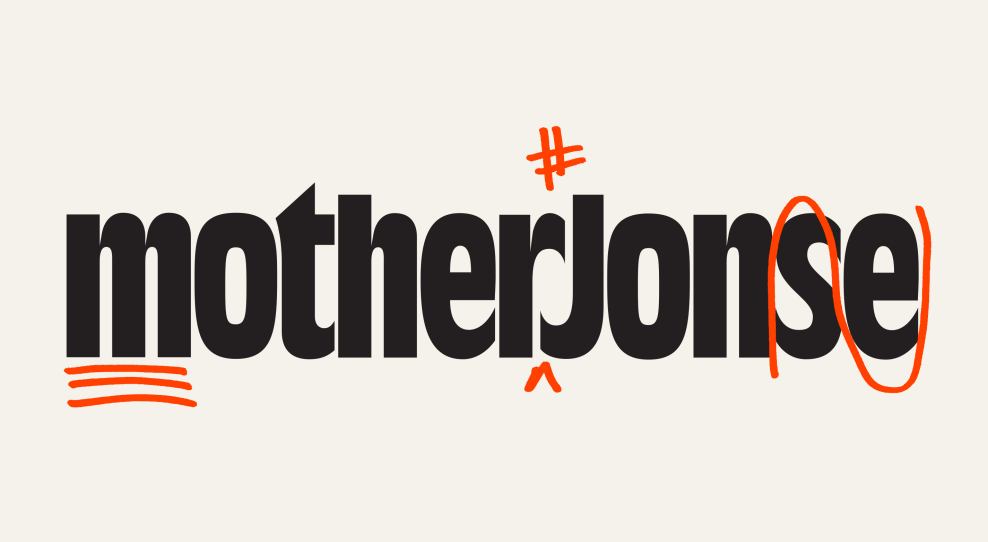
Capitalize "m," insert space, transpose "s" and "e," and get your editor a doughnut (not a donut), a goddamn ice cream sandwich (not goddam and not ice-cream sandwich), or a bottle of whiskey (not whisky, unless you're outside the United States and Ireland, like in Scotland, India, Japan, or Canada).Mother Jones illustration
It didn’t take long for 2020 to become the kind of rumbling, brink-of-war election year that 2019 foreshadowed, with President Trump’s overseas outbursts and domestic distractions threatening to fog up impeachment and the election. As the year unfolds, Mother Jones and the rest of the national media have our work cut out for us, from fact-checking to reality-checking, which takes more than reporting. In the Trump era, it takes seeing through smokescreens in the media, scare tactics in government, and language tricks everywhere. Words’ meanings are increasingly heightened; it matters what “white supremacy” and “white nationalism” mean, “extortion” and “quid pro quo” mean, “cancel culture” means, “detention” means. To that end our staff has been debating and rewriting our style guide to make sure it reflects the most accurate, accountable language in areas of race, gender, abortion, incarceration, immigration, climate science, and more.
Today, Mother Jones is publishing its style guide, the handbook our editors and reporters use for internal guidance on word choice. It’s the first time in our 44-year history that we’re releasing it publicly.
We’re sharing it to encourage readers, and ourselves, to learn out loud about words’ consequences and constraints. What this means is a living guide that’s constantly updated, but whose goals are unchanging: challenge hidden biases in language, avoid euphemisms that creep into national vocabulary (like “internment” when you mean incarceration), and amplify a diverse range of voices. Find our guide here.
A handful of newsrooms have released theirs: BuzzFeed News, the Guardian, the New York Times, Rewire.News, BBC. More newsrooms should tip their hands. Some highlights in ours: distinctions between disinformation and misinformation; suppression and depression of voter turnout; victims and survivors. You’ll see a default to gender-neutral occupational titles (with exceptions) and climate language like accepting scientific facts instead of believing in them.
Questions we’re debating:
• When should we use Latinx? Check our entry; see if you agree.
• Should Black and Brown always be capitalized (but not white) in all references to race or should Mother Jones defer to individual writers’ and sources’ discretion (as we do now) to affirm personal choice even at the cost of consistency?
• What’s the distinction between “white supremacy” and “white nationalism”? See our entry.
• Should we drop the hashtag from #MeToo to reflect the movement’s broadening beyond its social media origins?
• Should we replace “conspiracy theory” with “conspiracy claim” (or a term like it) to preserve the scientific meaning of theory as an accepted body of explanations, the opposite of the flatly wrong just-a-theory use, as some scientists are pitching us to do? Or allow both meanings?
• Should we use “lab-grown” or another term for synthetically grown animal meat?
The biggest fallacy to avoid in style guides: the false choice between descriptivism and prescriptivism. What a scam. We’ve been sold this myth that style manuals have to choose between describing or prescribing how words work. But each requires the other. You can order a la carte.
There are some gutlessly neutral, deeply flawed style guides out there. One news organization’s—left unnamed as a courtesy (the news org is good but its style guide is abysmal)—has this dose of overcorrection: “Do not label a person as racist.” Because, we’re told, “source dignity and reader clarity are prioritized when specific actions, rather than general labels, are specified in a story.” In what world of dignity and clarity does banning “racist” make sense? This kind of hedging and shuffling and sleight of hand is exactly what repulses readers and allows racism to go unnamed. Accuracy requires the word when it clearly applies.
Another dose of overcaution from a newsroom’s internal guidelines: “‘Terrorism/terrorists’: Do not use. One person’s terrorist is another’s freedom fighter.” False equivalencies like this are a familiar misfire from down-the-middle, earnest editors with good intentions but bad grammar and misguided politics. This is a pendulum swing past the best balance. “Terrorist” can be used as clearly to describe white supremacist terrorists as jihadist terrorists and anyone else who meets an exacting definition based on ideology, intent, and impact. The word is not empty, innately subjective, or bluntly bigoted as an instrument of empire in all cases; allow and use the word accurately. Banning it would only confirm the serious charge that progressive-posturing reporters resort to cherry-picked euphemisms instead of drawing hard distinctions and calling something exactly what it is.
While Mother Jones does not hesitate to take a stand—see our guidelines on ability and disability, religion and atheism, abortion and law—we also don’t make blanket pronouncements in cases where there’s good reason to leave things open or let writers and sources define their own terms.
Our style guide is here, always in progress. Reach us at styleguide@motherjones.com and weigh in with comments. Our copy team will answer all of your nontrolling questions (and most of your trolling ones). Enter the breach.

















